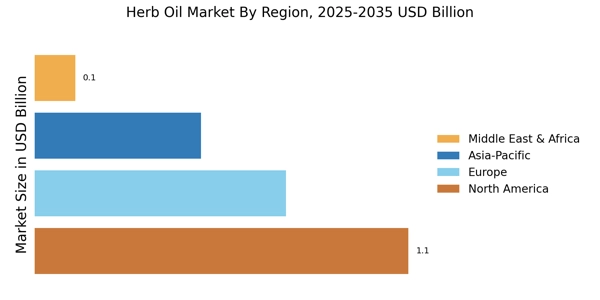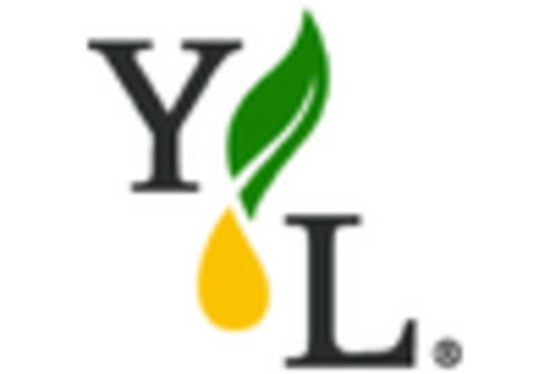The Herb Oil Market is currently characterized by a dynamic competitive landscape, driven by increasing consumer demand for natural and organic products. Key players such as Young Living (US), doTERRA (US), and Plant Therapy (US) are at the forefront, leveraging their strong brand recognition and extensive product portfolios. Young Living (US) emphasizes innovation in product development, focusing on high-quality essential oils sourced from sustainable farms. doTERRA (US), on the other hand, has adopted a strategy centered around community engagement and education, enhancing customer loyalty through workshops and training. Plant Therapy (US) positions itself as a value-driven alternative, offering a wide range of affordable yet high-quality herb oils, which appeals to a broader consumer base. Collectively, these strategies contribute to a moderately fragmented market, where brand loyalty and product differentiation play crucial roles in shaping competitive dynamics.
In terms of business tactics, companies are increasingly localizing manufacturing and optimizing supply chains to enhance efficiency and reduce costs. This trend is particularly evident as firms seek to respond swiftly to changing consumer preferences and market demands. The competitive structure of the Herb Oil Market remains moderately fragmented, with several key players exerting influence over pricing and product availability. The collective actions of these companies indicate a shift towards more localized production and sustainable sourcing practices, which are becoming essential in maintaining competitive advantage.
In August 2025, doTERRA (US) announced a partnership with a leading agricultural technology firm to enhance its supply chain transparency and sustainability efforts. This strategic move is significant as it not only aligns with growing consumer expectations for ethical sourcing but also positions doTERRA as a leader in sustainability within the herb oil sector. By integrating advanced technology into its supply chain, doTERRA aims to improve traceability and ensure that its products meet the highest standards of quality and sustainability.
In September 2025, Young Living (US) launched a new line of herb oils specifically designed for wellness applications, targeting the growing health-conscious consumer segment. This initiative reflects Young Living's commitment to innovation and its ability to adapt to market trends. By expanding its product offerings, the company seeks to capture a larger share of the wellness market, which is increasingly becoming a focal point for consumers seeking natural remedies.
In October 2025, Plant Therapy (US) introduced a subscription service for its herb oils, allowing customers to receive curated products monthly. This strategic action is indicative of a broader trend towards personalized consumer experiences. By offering a subscription model, Plant Therapy not only enhances customer retention but also capitalizes on the growing demand for convenience in purchasing natural products.
As of October 2025, the Herb Oil Market is witnessing trends such as digitalization, sustainability, and the integration of artificial intelligence in product development and marketing strategies. Strategic alliances among key players are increasingly shaping the competitive landscape, fostering innovation and collaboration. Looking ahead, it appears that competitive differentiation will evolve from traditional price-based competition to a focus on innovation, technological advancements, and supply chain reliability. Companies that can effectively leverage these trends are likely to secure a competitive edge in the ever-evolving herb oil market.


















Leave a Comment